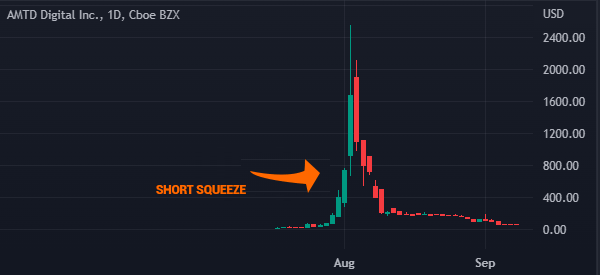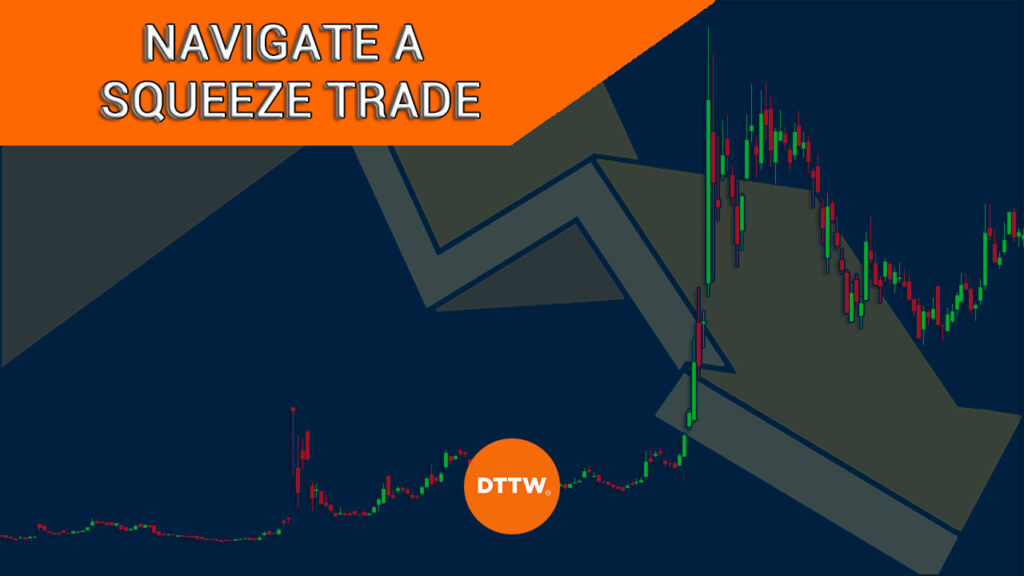A short squeeze is a concept that has become popular in the financial market recently. It refers to a situation where a financial asset like a cryptocurrency and a stock suddenly goes parabolic for no apparent reason.
In this article, we will look at some of the top strategies to navigate a short squeeze.
Table of Contents
What is a short squeeze?
To understand what a short squeeze is, it is important to know what short-selling is. A short is a situation where a trader bets that an asset price will go down. As a result, they open a trade that is intended to benefit when the asset drops.
Behind the scenes, short-selling is a highly complicated process.
A trader borrows shares from a broker and then sells them. In this case, they remain with cash at hand. Now, if the stock falls, they execute a buy trade and return the borrowed shares to the broker.
Being long and short a financial asset has its differences. When you buy a stock, the maximum loss you can make is losing all your money. On the other hand, when you are short an asset, your biggest loss potential is infinity since a stock has no limit on how high it can go.
A short squeeze is a period when a stock rises sharply and forces short-sellers to either sell or even make substantial losses.
Related » Bear Market: What Is It?
Examples of short squeezes
The best example of a short squeeze is one that happened between billionaires Bill Ackman and Carl Icahn. The situation happened when Ackman sued and won against Icahn. After that, Ackman took a large short position on a company known as Herbalife. He accused it of being a pyramid scheme.
Carl Icahn then decided to take a long position on the company, pushing its stock price higher. In the end, Ackman suffered a strong short squeeze and lost over $1 billion.
Another example of a short-squeeze is when a company known as AMTD soared by more than 20,000% after it went public.
Other examples are companies like Bed Bath & Beyond, AMC, and GameStop. These companies, which had a high short interest went parabolic As a result, many short-sellers like Melvin Capital went under.

Further, in the past few years, we have seen many companies stocks jump after announcing that they will go bankrupt. It happened in companies like Hertz and Revlon.
While these short squeezes make headlines, the reality is that they are extremely popular in the market. They are more popular in penny stocks and even cryptocurrencies.
How to navigate a short-squeeze
There are several approaches to navigating a short-squeeze situation. Basically there are two steps to follow to make the most of this situation.
Identification
First, you should work to identify these squeezes. One of the best ways to do that is to use pre-market movers or top movers tool in the market.
This is a tool that shows stocks that are making substantial moves. For a short squeeze, you should identify companies that are soaring.
Related » How to Identify Short Covering as It Happens!
In-depth analysis
Second, you should dig deeper to identify the catalyst of the stock that is rising. You can do that by just conducting a Google search to find out why a stock is rising. You can also take advantage of the Google News tab for this type of research.
Have you found any headlines? If there is no catalyst, then there is a probability that the stock is soaring because of a short squeeze.
Combining the two above
If the two solutions above seemed right to you, but a bit tricky, this is the perfect solution for you. This simple approach only requires you to subscribe to a watchlist that simplifies this process.
Our watchlist at Real Trading (via TraderTv.Live) sends you more information about stocks making big moves in the market.
How to trade a short squeeze
Trading a short squeeze is not easy. Still, there are several things you need to know.
Fundamentals are not required
First, in a short squeeze, the fundamentals of a company don’t matter. News analysis is important, but only to understand whether the sharp movement is driven by the news or not. As we have said above, the short squeeze is not driven by headlines.
As such, you should not put much emphasis on a company’s fundamentals like earnings and industry. Instead, you should focus on technical and price action analysis.
Do not time the market
Second, you should avoid timing the market. Timing the market is a situation where you predict where the stock will move to in the near term.
For example, in the chart above, we see that AMTD shares rose from about $10 to over $2,500 within a short period. Therefore, a trader timing the market would have placed a short trade when it soared to $100.
As you can see, such a trade was wrong. You should only short an asset when you see bearish sign of distribution set in.
Protect yourself. Always.
Third, in a short squeeze, you should always have a stop-loss and a take-profit. These tools will stop your trades at specific places. A stop-loss will stop it when it reaches a certain loss level while a take-profit will stop it when it reaches a preset profit level.
The benefit of protecting your trades is that the chart can move in either direction during a short squeeze.
Size your trades
Fourth, position sizing is an important part of trading during a short squeeze. Ideally, you don’t want to risk a lot of money in a highly volatile stock squeeze.
As a result, ensure that the funds you are risking don’t expose you to substantial risks.
Use more than one timeframe
Finally, conducting a multi-timeframe analysis will help you identify key levels in a short squeeze. This is an analysis that involves looking at several timeframes like daily, four-hour, and one-hour.
You can also decide to avoid the short squeeze and stay safe.
Summary
In this article, we have identified what a short squeeze is and some of the best strategies to use when trading with it. We have also noted some of the top precautions to use when you have identified a squeeze.
External useful resources
- Banks can help consumers navigate through the squeeze – UkFinance



